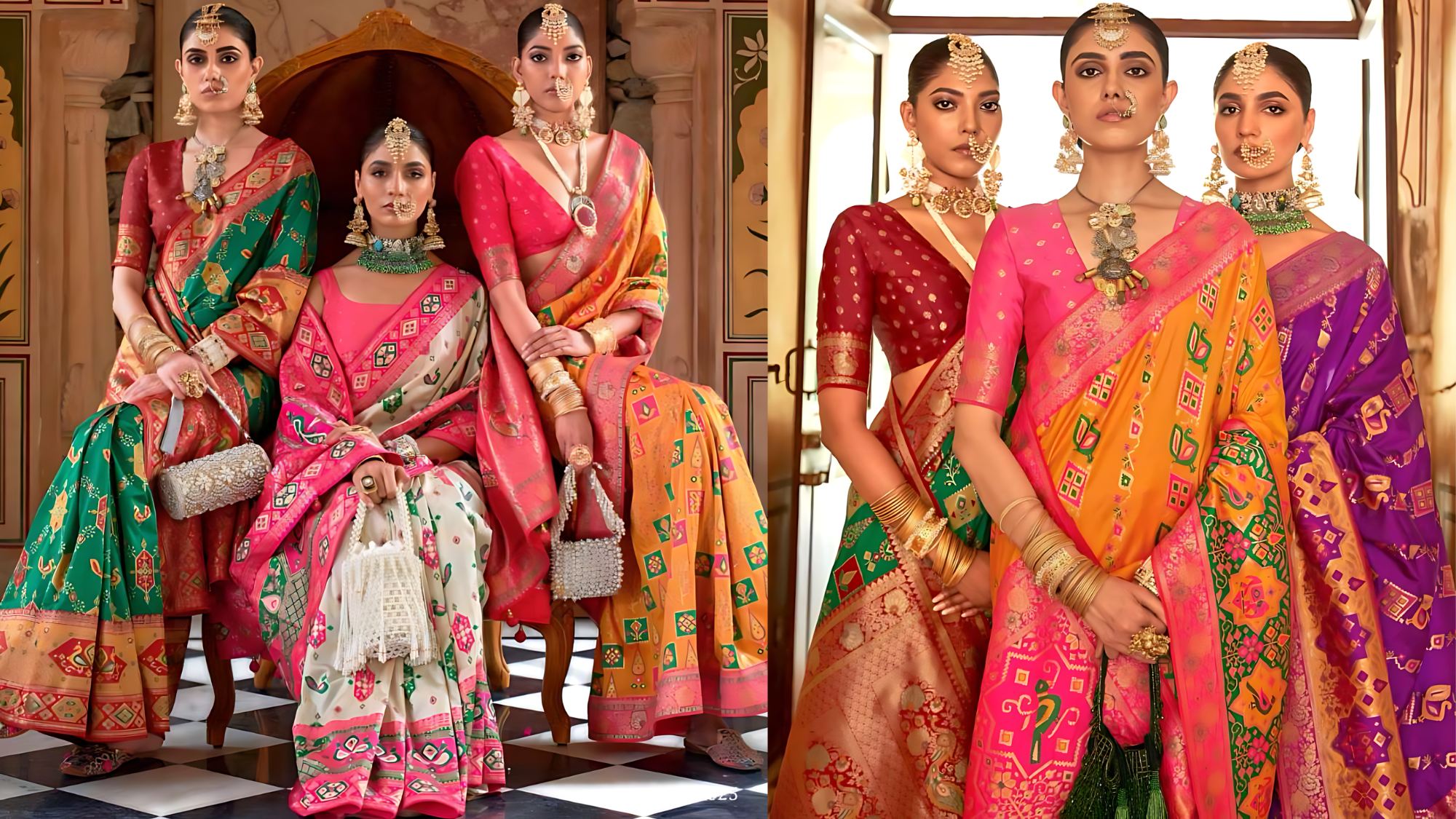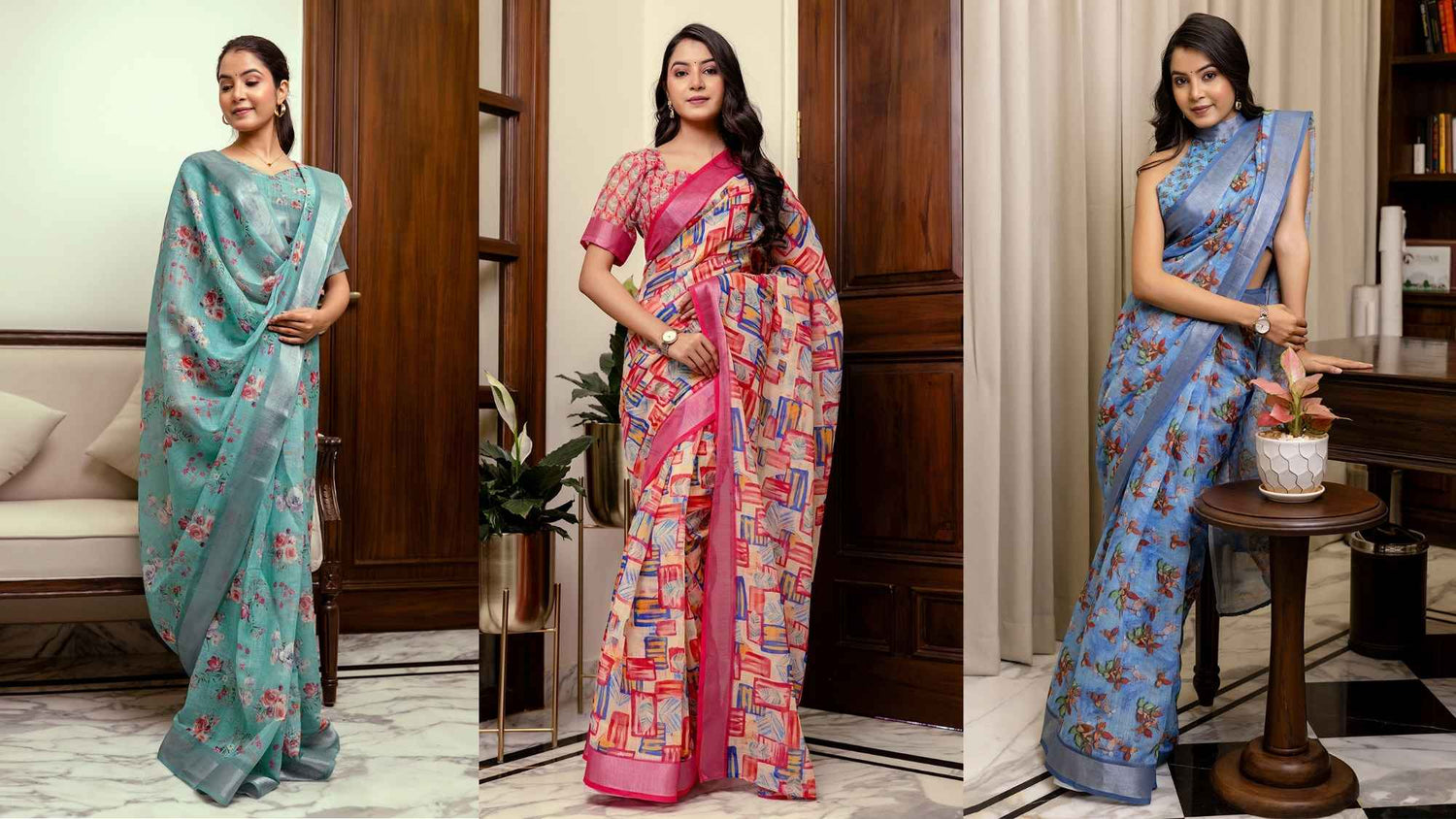Silk sarees are an important part of India's textile heritage, known for their beauty and detailed craftsmanship. Different regions in India have their own unique weaving styles and patterns, showing their cultural and artistic traditions.
Among the varieties, five exceptional silk sarees stand out: Ikkat, Kadwa, Kasavu, Meenakari, and Aari Weave. Each of these sarees tells a story of historical significance, meticulous artistry, and regional pride.
In this blog, we will dig into the fascinating histories, facts, and detailed processes behind these silk sarees, while also highlighting the places where they are most known. Whether it's the designs of Ikkat, the detailed motifs of Kadwa, the elegant simplicity of Kasavu, the vibrant colours of Meenakari, or the delicate embroidery of Aari Weave, these sarees are with it’s diverse beauty and craftsmanship that make Indian silk sarees world-famous.
Ikkat: A Unique Textile Art
The term "ikkat" refers to the unique dyeing technique used to create the sarees, where the threads are tie-dyed before weaving to produce elaborate designs. This labour-intensive process involves skilled artisans who carefully bind sections of yarn and dye them in various stages to achieve the desired patterns.
There are three main types of Ikkat:
- Warp Ikat: Only the warp threads (the threads that run vertically) are dyed before weaving. The weft threads (the horizontal threads) are plain.
- Weft Ikat: Only the weft threads are dyed. The patterns emerge as the fabric is woven.
- Double Ikat: Both the warp and weft threads are dyed before weaving. This is the most complex and intricate form of Ikat, requiring great skill and precision.
Ikat in India
India is famous for its Ikat textiles, with different regions producing their own distinct styles:
1) Pochampally Ikat (Telangana and Andhra Pradesh)
2) Patola Ikat (Gujarat)
3) Sambalpuri Ikat (Odisha)
Kadwa: Exquisite, Intricate Craftsmanship
Kadwa silk sarees, originating from the ancient city of Varanasi (Banaras) in India, are famous for their involved and elaborate weaving techniques. The history of Kadwa silk dates back several centuries, rooted deeply in the rich cultural heritage of Indian textiles.
The process of making these sarees is intensive, involving traditional handloom techniques where each motif is woven separately, resulting in elegant designs with remarkable detailing and precision. This method, known as "Kadwa" or "Kadhua," distinguishes these sarees from others by ensuring that the motifs do not have any loose threads at the back, adding to their durability and elegance.
Kadwa silk sarees come in various types:
1) Banarasi Kadwa
2) Tanchoi
3) Jangla
Each characterised by unique patterns and styles. These sarees are particularly famous in regions such as Varanasi, Delhi, and Kolkata, and they hold a special place in Indian weddings and festive occasions, celebrated for their opulent appearance and cultural significance.
Kasavu: Traditional, Elegant Simplicity
Kasavu silk sarees, renowned for their simplicity, in the traditions of Kerala, India. These sarees, typically characterised by their off-white colour with a gold border, are a natural part of the state's cultural heritage.
The making of a Kasavu saree involves precisely hand-weaving on traditional looms, using fine silk threads. The golden borders are often woven with real gold or silver threads, which adds to their charm and value. There are different types of Kasavu sarees, varying in the elaborateness and width of the gold border, as well as the occasional addition of motifs and designs. They are especially famous in Kerala, particularly in regions like Kuthampully and Balaramapuram, where the weaving tradition has been preserved for generations. These sarees are a leading decoration during festivals, weddings, and other auspicious occasions in Kerala, symbolising purity and grace.
Meenakari: Intricate, Colorful Luxury
Meenakari silk sarees are a unique blend of sophisticated craftsmanship and luxurious fabric, symbol of rich history that dates back to the Mughal era. Originating in the royal courts of Rajasthan, the art of Meenakari, or coating, was traditionally applied to jewellery and later extended to textiles.
The process of making Meenakari silk sarees involves complicated hand-painting and weaving techniques. Artisans first sketch elaborate designs on silk fabric, often inspired by nature, tradition, and Mughal motifs. These designs are then brought to life with vibrant colours and delicate embroidery, sometimes incorporating zari work for added richness.
There are several types of Meenakari silk sarees, including Banarasi, Kanjivaram, and Paithani, each are well known by their regional weaving styles and design elements. These sarees are particularly famous in regions like Varanasi, Jaipur, and Kanchipuram, where the tradition of Meenakari is deeply ingrained in the local culture. The result is a stunning piece of wearable art that celebrates both the heritage and the skilled craftsmanship of its makers.
Aari Weave: Delicate, Detailed Artistry
Aari Weave silk sarees is a traditional craft of India, particularly in the states of Tamil Nadu and Andhra Pradesh. The difficult Aari embroidery technique, believed to have originated during the Mughal era, involves using a long needle with a hooked end, known as an "Aari" needle, to create detailed and elaborate patterns on the fabric.
This method allows artisans to produce fine, uniform stitches that form tricky floral, geometric, and representative designs, often embellished with sequins, beads, and stones. The process begins with selecting high-quality silk, which is then handwoven into sarees. Artisans sketch the admired patterns on the fabric and carefully work with the Aari needle to bring the designs to life.
There are various types of Aari Weave silk sarees, including Kanchipuram, Banarasi, and Pochampally, each celebrated by their unique patterns, colours, and weaving styles. These sarees are highly popular in places like Chennai, Hyderabad, and Bangalore, known for their rich textile heritage and vibrant markets. The well crafted craftsmanship and luxurious appeal of Aari Weave silk sarees make them a desired choice for special occasions and celebrations.
Conclusion
India's silk sarees are not just garments; they are pieces of art that symbolise centuries of tradition, culture, and skilled craftsmanship. Each saree, whether it's the complicated patterns of Ikkat, the elaborate motifs of Kadwa, the simplicity of Kasavu, the vibrancy of Meenakari, or the delicate embroidery of Aari Weave, tells a unique story of India's rich textile heritage.
Sudathi Silk Saree collection offers a look into this world of well crafted silk sarees, inviting you to experience the beauty and elegance of these timeless creations.







